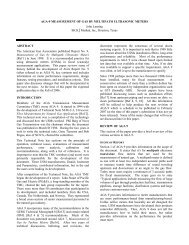Effects and Control of Pulsation in Gas Measurement
Effects and Control of Pulsation in Gas Measurement
Effects and Control of Pulsation in Gas Measurement
You also want an ePaper? Increase the reach of your titles
YUMPU automatically turns print PDFs into web optimized ePapers that Google loves.
possible to the orifice taps, typically with<strong>in</strong> 13<br />
<strong>in</strong>ches or less.<br />
Flanged connections with Teflon® seal’s<br />
elim<strong>in</strong>ate the "volume chambers" found with<br />
NPT connections. Multiple turn valves prevent<br />
"shock<strong>in</strong>g" <strong>of</strong> the measurement device when<br />
opened.<br />
Frequent valve stem pack<strong>in</strong>g adjustments are<br />
elim<strong>in</strong>ated by a dynamically loaded stem seal<br />
that is guaranteed leak-free under fluctuat<strong>in</strong>g<br />
pressure (vacuum to +10,000 PSI) <strong>and</strong><br />
temperature (-40° to +450°F).<br />
Protection <strong>of</strong> the electronic transmitters from<br />
cathodic protection currents <strong>and</strong> possible<br />
transients is provided through the use <strong>of</strong><br />
dielectric isolators, rated to 2,500 volts DC,<br />
located between the stabilized connectors <strong>and</strong><br />
the manifold.<br />
Summary<br />
• <strong>Pulsation</strong> created by compressors, flow<br />
control valves, regulators, <strong>and</strong> some pip<strong>in</strong>g<br />
configurations may create unacceptable<br />
levels <strong>of</strong> SRE <strong>and</strong>/or GLE.<br />
• %SRE is always positive, never negative,<br />
<strong>and</strong> <strong>in</strong>creases with pulsation amplitude.<br />
• To reduce pulsation to an acceptable level,<br />
the source <strong>of</strong> the pulsation must be<br />
elim<strong>in</strong>ated, pip<strong>in</strong>g systems modified, ∆P<br />
<strong>in</strong>creased, a restrict<strong>in</strong>g device <strong>in</strong>stalled, or a<br />
properly sized acoustic filter <strong>in</strong>stalled.<br />
• Whenever pulsation is present there is a<br />
high probability that GLE will exist.<br />
• Even though %SRE read<strong>in</strong>gs may be with<strong>in</strong><br />
acceptable limits, low amplitude/high<br />
frequency pulsations may create significant<br />
GLE.<br />
• Volume chambers, such as condensate<br />
pots, bottles, <strong>and</strong> bellows hous<strong>in</strong>gs <strong>of</strong><br />
different volumes greatly affect GLE.<br />
• Numerous measurement devices<br />
connected to the same set <strong>of</strong> orifice taps<br />
may create GLE.<br />
7<br />
• Unlike %SRE, GLE can be either positive or<br />
negative. It may be <strong>of</strong> a greater magnitude than<br />
%SRE.<br />
• To m<strong>in</strong>imize or elim<strong>in</strong>ate GLE, the transmitters or<br />
EFM should be close coupled to the orifice taps<br />
with equal length, large bore (0.375" I.D. or<br />
greater), constant diameter gauge l<strong>in</strong>es.<br />
• M<strong>in</strong>imiz<strong>in</strong>g or elim<strong>in</strong>at<strong>in</strong>g GLE by close coupl<strong>in</strong>g<br />
the measurement device to the orifice taps will<br />
not reduce %SRE.<br />
References<br />
1. McKee, Robert S. '<strong>Pulsation</strong> <strong>Effects</strong> on Orifice<br />
Meter<strong>in</strong>g Consider<strong>in</strong>g Primary <strong>and</strong> Secondary<br />
Elements," Proceed<strong>in</strong>gs <strong>of</strong> the Twenty-Second<br />
Gulf Coast <strong>Measurement</strong> Short Course, pp.<br />
112-118, 1989.<br />
2. Gegg, Debbie, "<strong>Effects</strong> <strong>and</strong> <strong>Control</strong> <strong>of</strong><br />
<strong>Pulsation</strong>'s <strong>in</strong> <strong>Gas</strong> <strong>Measurement</strong>," Arkia<br />
Energy Resources, Shreveport, La.<br />
Proceed<strong>in</strong>gs <strong>of</strong> the Sixty-Fourth International<br />
School <strong>of</strong> Hydrocarbon <strong>Measurement</strong>, pp. 331-<br />
335, 1989.<br />
3. Durke, Ray G. <strong>and</strong> Sparks, Cecil R., "<strong>Pulsation</strong><br />
<strong>and</strong> Transient-Induced Errors at Orifice Meter<br />
Installations,' PCRC Technical Report No. 87-<br />
3, 1987.<br />
4. Floyd, J.H. <strong>and</strong> Everett, W.S. "The Effect <strong>of</strong><br />
High Frequency <strong>Pulsation</strong>'s on Differential<br />
Meter<br />
Accuracy," Proceed<strong>in</strong>gs <strong>of</strong> the Twenty Third<br />
Appalachian <strong>Gas</strong> <strong>Measurement</strong> Short Course,<br />
pp. 283-294, 1963.<br />
5. Durke Ray G., Smalley, Anthony J., <strong>and</strong><br />
McKee, Robert J. "An Assessment <strong>of</strong><br />
Technology for Correct<strong>in</strong>g <strong>Pulsation</strong>-Induced<br />
Orifice Flow <strong>Measurement</strong> Errors," PCRC<br />
Technical Report No. TA 91-1, 1991.




